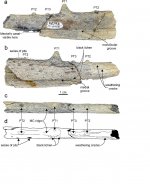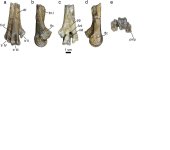Fred Ruhe
Well-known member

Peter A. Kloess, Ashley W. Poust & Thomas A. Stidham, 2020
Earliest fossils of giant-sized bony-toothed birds (Aves: Pelagornithidae) from the Eocene of Seymour Island, Antarctica
Scientific Reports. 10 (1): Article number 18286.
doi:10.1038/s41598-020-75248-6
Abstract: https://www.nature.com/articles/s41598-020-75248-6
While pelagornithid or ‘bony-toothed’ bird fossils representing multiple species are known from Antarctica, a new dentary fragment of a pelagornithid bird from the middle Eocene Submeseta Formation on Seymour Island, Antarctica represents a species with a body size on par with the largest known species in the clade. Measurements from the partial ‘toothed’ dentary point to a giant body size for the species, although the spacing among the pseudoteeth differs from that published for other pelagornithids. The discrepancy might suggest that previous techniques are not adequate for examination of incomplete material or that another factor such as phylogeny might impact size estimates and comparisons. Combined with a revised stratigraphic position in the early Eocene La Meseta Formation on Seymour Island for the largest pelagornithid tarsometatarsus known, these Antarctic fossils demonstrate the early evolution of giant body size in the clade (by ~ 50 Ma), and they likely represent not only the largest flying birds of the Eocene but also some of the largest volant birds that ever lived (with an estimated 5–6 m wingspan). Furthermore, the distribution of giant-sized pelagornithid fossils across more than 10 million years of Antarctic geological deposits points to a prolonged survival of giant-sized pelagornithids within the southern seas, and their success as a pelagic predatory component of marine and coastal ecosystems alongside early penguins.
Free pdf: https://www.nature.com/articles/s41598-020-75248-6.pdf
Enjoy,
Fred
Earliest fossils of giant-sized bony-toothed birds (Aves: Pelagornithidae) from the Eocene of Seymour Island, Antarctica
Scientific Reports. 10 (1): Article number 18286.
doi:10.1038/s41598-020-75248-6
Abstract: https://www.nature.com/articles/s41598-020-75248-6
While pelagornithid or ‘bony-toothed’ bird fossils representing multiple species are known from Antarctica, a new dentary fragment of a pelagornithid bird from the middle Eocene Submeseta Formation on Seymour Island, Antarctica represents a species with a body size on par with the largest known species in the clade. Measurements from the partial ‘toothed’ dentary point to a giant body size for the species, although the spacing among the pseudoteeth differs from that published for other pelagornithids. The discrepancy might suggest that previous techniques are not adequate for examination of incomplete material or that another factor such as phylogeny might impact size estimates and comparisons. Combined with a revised stratigraphic position in the early Eocene La Meseta Formation on Seymour Island for the largest pelagornithid tarsometatarsus known, these Antarctic fossils demonstrate the early evolution of giant body size in the clade (by ~ 50 Ma), and they likely represent not only the largest flying birds of the Eocene but also some of the largest volant birds that ever lived (with an estimated 5–6 m wingspan). Furthermore, the distribution of giant-sized pelagornithid fossils across more than 10 million years of Antarctic geological deposits points to a prolonged survival of giant-sized pelagornithids within the southern seas, and their success as a pelagic predatory component of marine and coastal ecosystems alongside early penguins.
Free pdf: https://www.nature.com/articles/s41598-020-75248-6.pdf
Enjoy,
Fred





